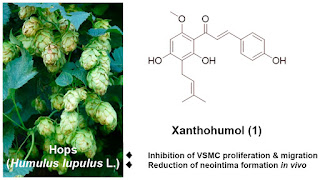Floating sidebar
The International Natural Product Science Taskforce (INPST)
Translate
Xanthohumol, bioactive phytochemical from hops, counteracts blood vessel narrowing processes
Abstract (as presented by the authors of the scientific work):
"Xanthohumol (1) is a principal prenylated chalcone found in hops. The aim of this study was to examine its influence on platelet-derived growth factor (PDGF)-BB-triggered vascular smooth muscle cell (VSMC) proliferation and migration in vitro and on experimentally induced neointima formation in vivo. Quantification of resazurin conversion indicated that 1 can inhibit PDGF-BB-induced VSMC proliferation concentration-dependently (IC50 = 3.49 μM). Furthermore, in a wound-healing assay 1 potently suppresses PDGF-BB-induced VSMC migration at 15 μM. Tested in a mouse femoral artery cuff model, 1 significantly reduces neointima formation. Taken together, we show that 1 represses PDGF-BB-induced VSMC proliferation and migration in vitro as well as neointima formation in vivo. This novel activity suggests 1 as an interesting candidate for further studies addressing a possible therapeutic application to counteract vascular proliferative disease."
Graphical abstract:
Results and discussion (as presented by the authors of the scientific work):
"In order to test whether 1 is able to inhibit growth-factor-induced proliferation of VSMCs, its influence on the total cellular metabolic activity of VSMCs was measured by the resazurin conversion method. PDGF-BB was used as a promitogenic stimulus in this study. Total metabolic activity was measured 48 h after PDGF-BB treatment of VSMCs, which were already preincubated with vehicle or 1 (1–15 μM) for 30 min. Indeed, 1 inhibited PDGF-BB-induced VSMC proliferation concentration dependently, with an IC50 value of 3.49 μM (Figure 2A). To ensure that the decreased VSMC number upon treatment with 1 is due to proliferation inhibition and not cytotoxicity, we quantified cytosolic lactate dehydrogenase (LDH) inside the cells and in cell supernatants upon exposure to 1. No significant cytotoxicity was detected in the investigated concentration range (Figure 2B).
To investigate whether 1 can also inhibit PDGF-BB-induced VSMC migration, we performed a wound-healing assay in the presence of 1. After preincubation with vehicle or 1 (5 or 15 μM) for 30 min, the scratched VSMCs were treated with PDGF-BB and incubated for the next 20 h. Photos of the “wound” in the VSMC monolayer at the beginning (t = 0 h) and the end (t = 20 h) were taken, and the cell recolonization rate was analyzed. Upon stimulation with PDGF-BB, control cells were able to significantly recover the cell-free area (∼3.5-fold compared to unstimulated cells). Co-treatment with 15 μM 1 showed potent inhibition of PDGF-induced VSMC migration, allowing cell motility only in the range of the basal unstimulated control group (Figure 3).
We then examined whether 1 can also prevent neointima formation in vivo. The mouse femoral artery cuff model represents an animal model used to examine vessel responses to injury that are relevant for restenosis.(26-28) The femoral artery cuff placement leads to predictable neointima formation in mice over a 14-day period.(28) To assess the effect of locally applied 1 on the cuff-induced restenosis, 1 was dissolved in F-127 gel and placed in the cuff surrounding the femoral artery. Compared to sham-operated vessels, injured vessels displayed significant neointima formation 14 days after the cuff placement, which could be significantly attenuated by treatment with 1 (Figure 4).
Aberrant VSMC proliferation and migration are major events in atherosclerosis and restenosis progression. Therefore, identification of phytochemicals able to suppress VSMC proliferation and migration is of potential therapeutic relevance. Hops have been widely used since ancient times not only in the manufacturing of beer, but also as a medicinal plant. As the most abundant prenylated flavonoid in hops, 1 attracts an increasing amount of attention due to a variety of newly described health-promoting activities. To our knowledge, the present study is the first to show that 1 also suppresses proliferation and migration of PDGF-BB-induced VSMCs in vitro and reduces neointima formation in vivo. Further studies will be necessary to dissect the underlying molecular mode of action. Due to its electrophilic nature, 1 directly affects several cellular targets and signaling pathways(29) and modulates activity of kinases, such as Akt and AMPK, and of transcription factors, such as Nrf2, NF-kB, or STAT3.(19, 30, 31) All those signaling molecules may conceivably contribute to the reduced neointima formation. Therefore, it is highly likely that the antihyperplastic effect of 1 observed in this study cannot be pinned down to one single molecular target or pathway but rather exploits the pronounced polypharmacology of 1."
Full-text access of the referenced scientific work:
Xanthohumol Blocks Proliferation and Migration of Vascular Smooth Muscle Cells in Vitro and Reduces Neointima Formation in Vivo
Rongxia Liu, Elke H. Heiss, Daniel Schachner, Baohong Jiang, Wanhui Liu, Johannes M. Breuss, Verena M. Dirsch, and Atanas G. Atanasov
Journal of Natural Products, DOI: 10.1021/acs.jnatprod.7b00268
https://www.researchgate.net/publication/317664462_Xanthohumol_Blocks_Proliferation_and_Migration_of_Vascular_Smooth_Muscle_Cells_in_Vitro_and_Reduces_Neointima_Formation_in_Vivo
Subscribe to:
Posts (Atom)

You may step-ahead
ReplyDeleteAs a reliable supplier, Creative Enzymes supplies the products of high quality and competitive cost performance. We cooperate with a large number of satisfied customers in corresponding fields all over the world. Xanthohumol
ReplyDelete